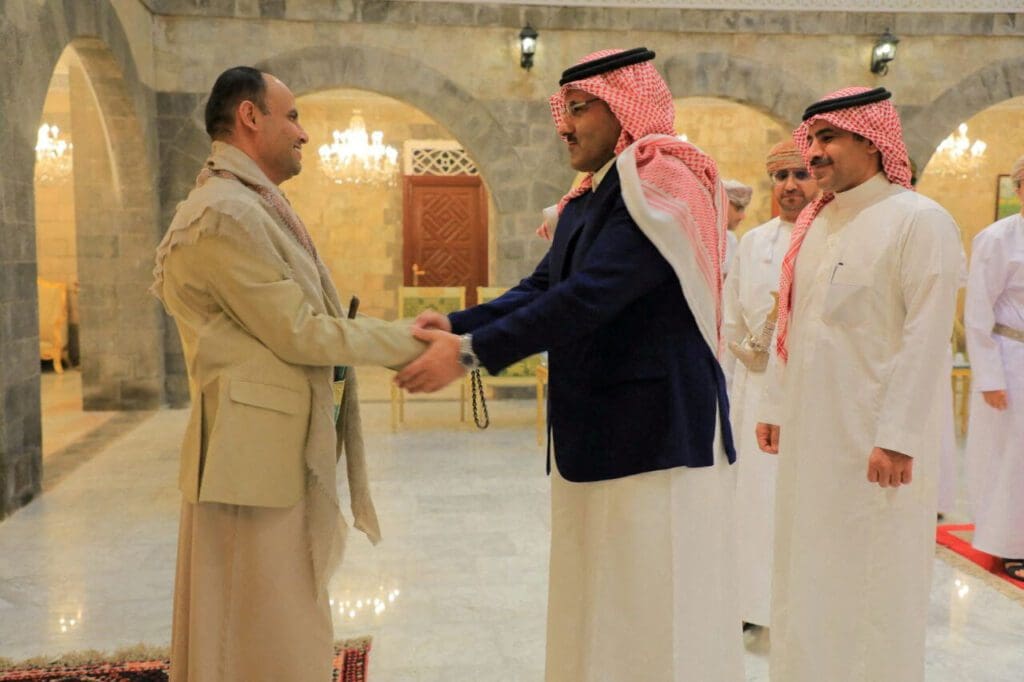A diplomatic agreement between Saudi Arabia and Iran has raised hopes that it could lead to a peace agreement in Yemen, where war has raged with the help of both parties for over eight years. Over the past week, Houthi officials have been holding peace talks in Sanaa with a delegation led by Saudi Ambassador to Yemen Mohammed bin Saeed Al-Jaber and an Omani mediation team.
The Sanaa meeting signals that a Saudi-Houthi ceasefire agreement is imminent and that Riyadh is willing to progressively formalize Houthi gains and concede to their demands. But without the buy-in of other local actors, the war is likely to continue and the agreement only serves the Houthi’s consolidation of power.
There are indications that the ceasefire agreement will include commitments to direct talks between the Yemeni government and the Houthis. However, the two parties will need to further demonstrate their acceptance of these terms and any subsequent negotiations must expand to include all relevant factions to achieve a durable peace.
Saudi Arabia and Iran’s deal in early March to restore diplomatic relations fueled optimism about an end to the war between Yemen’s Saudi-backed government and Iran-allied Houthi rebels. But less than two weeks later, fighting erupted again, ending a six-month de facto ceasefire and signaling that rapprochement between the two regional powers is unlikely to bring peace to Yemen.
The latest clashes in Marib province and elsewhere indicate that for the Houthis, the Iran-Saudi deal could provide an opportunity to seize additional territory amid de-escalation from other parties. The Houthis have little reason to believe that such regional developments will serve their interests. They also have a track record of exploiting previous negotiations to consolidate their power.
A Saudi-Iranian détente is a necessary step towards stabilizing Yemen, but it is only one factor in a war that is driven as much by local factors as by regional rivalries. Therefore, a lasting peace in Yemen will require all major parties to the war to be at the negotiating table.
De-escalation or Tactic of War?
A deal between Yemen’s government and the Houthis to begin exchanging prisoners on April 11 has also been hailed as a step towards de-escalation. However, the swap appears heavily weighted in favor of the Houthis, who have agreed to release just 181 detainees in exchange for 706 released by the government. Ahead of the recent Sanaa meeting, as part of the larger prisoner exchange, the Houthis released one Saudi detainee in exchange for 13 released by the Saudi government. The Houthis have not been receptive to pressure from the mediators of the United Nations and the International Committee of the Red Cross to hand over their remaining captives in an “all for all” deal.
Furthermore, despite the Saudi-Iran deal and the delicate nature of the ongoing ceasefire negotiations in Sanaa, the Houthis have continued to suppress dissent, sentencing four critics to prison (although later pardoning them) and allegedly torturing and killing one of them, a popular activist in Ibb named Hamdi Abdul Razaq. Hence the prisoner exchange should not be seen in isolation or read as a sign that the Saudi-Iran deal is leading to de-escalation. Rather, it should be viewed as a tactical move by the Houthis to extract more concessions from Riyadh.
Past negotiations and ceasefires have largely served to assist the Houthis in consolidating their power, and the latest appears to have been no exception. Following reports of unofficial Saudi-Houthi talks earlier this year, the American, British, and French navies have reported seizing growing numbers of ships carrying arms from Iran to Yemen. This indicates that neither Tehran nor the Houthis are engaging talks in good faith, but rather exploiting them to consolidate their military positions and prepare for the next round of war.
The reality on the ground is that the calm since April 2022 has merely enabled the Houthis to mobilize more fighters and augment their arsenal, with help from Tehran. Recent clashes indicate that the Houthis want to prove they are able to continue fighting, regardless of the Saudi-Iran deal. They are also hoping to seize control of Marib and its oil before any potential political settlement.
Neither the Saudi-Iran deal nor any Saudi-Houthi talks in its wake are likely to bolster the position of the Yemeni government. If past negotiations are any indication, the main result of the agreement that currently being negotiated is likely to be a strengthening of the Houthis’ position at the government’s expense. Moreover, even if the Saudi-Iran rapprochement leads to more Saudi-Houthi negotiations in the future, and potentially a renewed ceasefire arrangement, such talks will not generate a roadmap to sustainable peace as long as they continue to risk marginalizing other crucial domestic actors.
More than a Proxy War
The war in Yemen involves a range of domestic and regional parties. Since its outbreak, it has fragmented the country and seen the Houthis emerge as a major player, seizing much of northern Yemen and the capital Sanaa at the end of 2014. As a result, the Saudi-led coalition, armed by the U.K. and U.S., intervened in 2015 with troops from five of six member states of the Gulf Cooperation Council (GCC)—excluding Oman and including Qatar only until the 2017 GCC rift—as well as other Arab countries. The intervention’s aim was to counter Iranian influence and re-establish the internationally recognized Yemeni government’s control. As Saudi and Iran back opposing factions, some analysts have characterized the intervention as a proxy war between regional rivals.
But the main drivers of the conflict were, and remain, local. The Houthis launched a rebellion at the beginning of the millennium with the ideological aim of restoring the historical, theocratic Zaidi State—Zaidism is a sect of Shia Islam from which the Houthi movement derives their legitimacy and ideological discourse. Their motivations range from a desire to monopolize power to a rejection of Saudi and Western interference in Yemeni politics. The Southern Movement also emerged with the aim of returning to an earlier era, restoring the pre-1990 People’s Democratic Republic of Yemen (PDRY) in the south. Both the Houthis and the Southern movement were able to exploit the agendas of regional powers to drum up external support for their respective projects. At the same time, the war is firmly rooted in historical grievances along local fault lines, with both movements pursuing their domestic agendas irrespective of their regional backers’ interests.
As such, the Saudi-Iran détente is one factor among many that could contribute to, but will not solely tip the scales in favor of, peace. While tension between the regional powers has exacerbated the war, regional reconciliation alone is not sufficient to end it. The Houthis have little reason to trust outside actors to work in their best interests—even Iran. Some within the Houthi camp have already signaled their autonomy from Tehran. Resumed fighting after the Saudi-Iran agreement is another sign that domestic actors will continue their attempts to consolidate control in spite of regional developments.
Furthermore, history demonstrates that war in Yemen may prove persistent even after regional actors withdraw. During the civil war in the 1960s, Egypt and Saudi Arabia—the main external backers of the Yemeni parties—agreed to withdraw from the Yemen war in 1967. But the war stretched on three years afterwards, regardless. If history repeats itself, Saudi Arabia may withdraw from Yemen after ensuring the security of its borders, and Iran may reduce its support for the Houthis, but the war will continue until local actors are ready to reach a comprehensive settlement or one of them prevails.
‘Neither War nor Peace’
The international community has welcomed the Saudi-Iran agreement with great hope for Yemen. White House National Security Council spokesman John Kirby said resolving the war in Yemen was a priority for Washington. U.N. special envoy for Yemen Hans Grundberg described the deal as an “opportunity … to move towards a more peaceful future.” Iran’s permanent representative to the U.N. announced that warming regional relations would accelerate the return of a truce in Yemen. Regional and international powers have sought to pressure Yemeni parties to renew the ceasefire and reach a political settlement.
Only days ago, Saudi Arabia’s Ambassador to Yemen visited Sanaa alongside Omani mediators to negotiate a ceasefire with Mahdi al-Mashat, head of the Houthi’s supreme political council. This visit demonstrates that Saudi Arabia, which is fatigued by the war’s financial and political costs, is seeking an exit and willing to formalize the Houthi’s gains with international recognition. The kingdom’s efforts to pressure the Yemeni government and other parties to make concessions and reach a speedy settlement could push the parties into one that would formally divide the country and further expand the Houthi sphere of control.
The fallout from the 2018 Stockholm Agreement proves that hasty peacebuilding backed by self-interested international actors pressing for quick fixes only plays into Houthi hands, buying them time to cement military advantages. Following the Stockholm Agreement, analysts warned that international actors were normalizing Houthi territorial gains, particularly in Marib where fighting has since resumed.
The recent Saudi-Houthi talks and any ceasefire that may result from them risk similarly normalizing Houthi gains. Thus, any negotiations with the Houthis that exclude other internal actors will likely accomplish nothing more than delay the next round of fighting, since the Houthis appear to be concerned primarily with monopolizing power—not power-sharing arrangements with other factions. Even if a Saudi-Houthi ceasefire is reached in the coming weeks, the status quo of “neither war nor peace” will persist until a local settlement inclusive of all relevant actors is reached or internal dynamics drastically shift in favor of one party after a new round of fighting.



